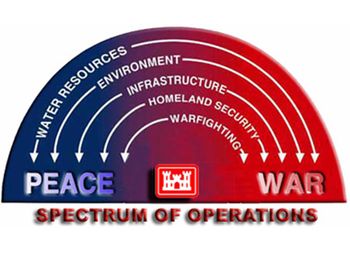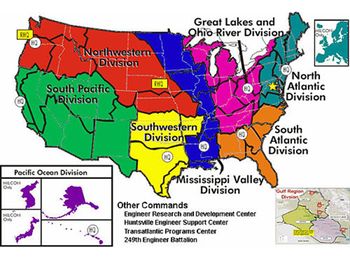US Army Corps of Engineers’ Coastal Programs
The US Army Corps of Engineers (USACE) [1] is a federal agency within the Department of Defense mandated to provide both military and civil works services. In coastal regions, its primary roles include protecting and restoring habitat, maintaining navigable waters, conducting beach nourishment, undertaking flood control projects and regulating coastal restoration projects.
Contents
History
The USACE’s military service dates to 1775. Its first water works project began in 1812. After the passage of the Rivers & Harbors Act of 1899, the USACE regulated activities in navigable waterways. Passage of the Clean Water Act in 1972 vastly increased the USACE’s authority over dredging and filling in waters and wetlands. The Corps is the lead federal flood control agency and a major provider of hydroelectric energy. In the late 1960s, the Corps became a leading environmental preservation and restoration agency. It is a leading partner in one of the largest restoration projects ever attempted—restoration of the hydrologic regime in the Florida Everglades.
Goals
The Corps regulates all work in wetlands and navigable waters (suitable for the passage of vessels) of the United States. Its coastal management roles—e.g. navigation, erosion control, flooding and habitat restoration—fall under that part of the USACE mission focused on the environment and water resources. In 1990, environmental protection became one of the primary goals of water resources projects. In more recent years, small ecosystem restoration projects have been coordinated with navigation and flood control projects.
Governance Framework of the Program
The USACE is organized geographically by watershed boundaries. There are eight divisions in the US and 41 subordinate districts throughout the US, Asia and Europe.
Local and State governments must request Congress for assistance from the USACE. Congress directs the USACE to conduct a study to determine the merits of a proposed project. Studies have two phases: an initial reconnaissance to determine if there is a reasonable solution, followed by a full feasibility study to examine alternatives and select the project that best meets national and local needs. The local sponsor will often share the costs of the studies. If a project is approved, Congress must authorize the project and then necessary funding.
A major USACE responsibility is administering the wetlands permitting program under Section 404 of the Clean Water Act, which prohibits the discharge of pollutants into navigable waters without a permit. The Act also authorizes the USACE to issue permits for the discharge of dredged and fill material. To obtain a permit, project proponents must meet detailed environmental protection standards that have been established by EPA in consultation with the Corps. A major challenge of the program is determining which areas qualify for wetland protection. A wetlands delimitation manual developed in 1987 provides helps guide decision on whether to grant, deny or set conditions on permits. The USACE is required to consider "all factors in the public interest" including balancing economic development with environmental protection.
The Corps’ implementation of the section 404 program changed significantly in 2001 after a Supreme Court ruling stated that the Clean Water Act did not authorize the USACE to require a permit for filling isolated, intrastate, non-navigable water. Before then, all waters and wetlands in the United States were potentially subject to the USACE due to its authority over migratory bird habitat. The Supreme Court established, however, that habitat for migratory birds is not a sufficient criterion for the exercising of the USACE regulatory authority.
Core Programs
The USACE’s civil works in coastal regions fall into three broad areas: water infrastructure, environmental management and restoration, and response to disasters. Within these, its key functions relate to navigation, flood protection, sediment management and restoration.
- Navigation
USACE supports navigation by dredging and otherwise maintaining and improving shipping channels and ports. It maintains over 12,000 miles of inland waterways and 235 locks. It also maintains 300 commercial harbors and more than 600 smaller harbors.
- Flood Control
Flood control services were first offered in the mid-1800’s for the Mississippi River. These expanded in 1936 to provide flood protection to the entire country. Services range from the construction and maintenance of large dams and hurricane barriers to small levees and non-structural flood damage reduction measures such as zoning regulations, warning systems and flood proofing. The local sponsors are often the owners of the structures, though the USACE continues to operate 383 dams and reservoirs for flood damage reduction.
- Wetlands Restoration
In addition to its permitting authority for activities in wetland areas, the USACE is a major actor in wetland restoration. One of the most recent initiatives to restore America’s coastal habitat is the Estuary Restoration Act of 2000. Its purpose is to develop a national Estuary Habitat Restoration Strategy between the public and private sectors, restore one million acres of habitat by 2010, provide Federal assistance, and improve monitoring and research capabilities. The Act affects 30 states and five territories.
- Sediment Management
USACE has traditionally conducted beach nourishment in two ways. One is through site-specific beach nourishment projects authorized by Congress. The other is through construction and maintenance of navigation projects. The Corps’ shore protection projects are usually cost-shared with the State, the local jurisdiction where the project is located, or both. The cost sharing agreement usually calls for periodic re-nourishment, often over a period of 50 years. Beach quality materials from the dredging of harbors and channels can be placed on nearby beaches pending state and local approval. Starting in 2000, the Corps began the Regional Sediment Management (RSM) demonstration program that develops regional sediment budgets to guide alternative uses of sediment.
Effectiveness Unlike other Federal agencies that give out grants for others to implement projects, the USACE plans, design and manages most of their projects. However, they need to have budgetary approval from Congress for each project, including maintenance activities of existing projects. While maintaining authority may be advantageous for large projects, it creates inefficiencies for smaller projects.
Beach nourishment projects were studied in 1996 by the U.S. Office of Management and Budget. When averaged across projects, beach nourishment performed as designed.
The USACE civil works projects have been criticized for wasteful spending. The merits of projects are often debated on an engineering level. Some projects are believed to have used inaccurate or manipulated models during the study phase. Projects like the Mississippi River Gulf Outlet in southeast Louisiana are said to have had detrimental environmental effects and its economic benefits have been questioned. Faulty design and substandard construction have been cited in the failure of levees in the wake of Hurricane Katrina. The Water Resources Development Act of 2007 now requires peer review of Corps projects to address some of the questionable models used for developing USACE projects.
See also
Internal Links
- Channel Islands National Marine Sanctuary – Case Study
- US Coastal Zone Management Program
- Coastal Barrier Resources System
- Overview of Coastal Habitat Protection and Restoration in the United States
- Essential Fish Habitat
- Chesepeake Bay Program
- Clean Water Act
- US National Estuary Program
- US National Estuarine Research Reserve System
- US National Marine Sanctuaries
- US National Wildlife Refuge System
- Rhode Island Salt Pond Special Area Management Plan – Case Study
- US Sea Grant College Program
- Tampa Bay Estuary Program
External Links
- https://www.usace.army.mil/Missions/Environmental/Estuary-Restoration/
- USACE http://www.usace.army.mil/
- https://lacoast.gov/reports/program/CWPPRASOPVersion25.pdf
- USACE Wikipedia Article http://en.wikipedia.org/wiki/US_Army_Corps_of_Engineers
- USACE Regional Sediment Management Overview https://rsm.usace.army.mil/
References
- ↑ USACE Website http://www.usace.army.mil/
Please note that others may also have edited the contents of this article.
|

